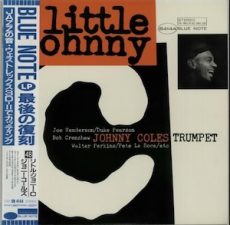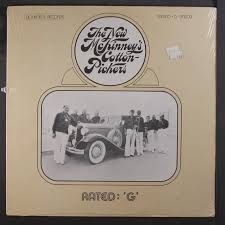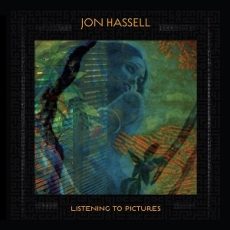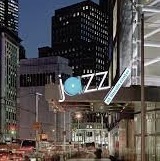
Requisites
Little Johnny C ~ Johnny Coles | By Eddie CarterIt happened like this: after listening to Bass on Top, my memories of my mom led me to another of her favorite jazz albums. Little Johnny C (Blue Note BLP 4144/BST 84144) by Johnny Coles is the trumpeter’s second release as a leader and his only Blue Note session. It was recorded in 1963 and released the following year. Johnny’s joined on this hard bop date by Leo Wright on alto sax (tracks: A1 to A3, B2, B3) and flute (B1), Joe Henderson on tenor sax, Duke Pearson on piano, Bob Cranshaw on bass, Walter Perkins (A1 to A3), and Pete La Roca (B1 to B3) on drums. My copy is the 1990 Toshiba EMI Japanese Stereo reissue sharing the original catalog number.
Little Johnny C is the first of five tunes by Duke Pearson. It kicks off Side One at a fast tempo with Duke’s brisk introduction to the front line’s lively theme. Leo comes out cooking first; then Johnny steps swiftly into the second statement. Joe wails in the following solo; then Duke shows his impressive skills into the group’s climax. Hobo Joe by Joe Henderson is a Latin-flavored blues that opens with the trio’s introduction, ahead of the sextet’s easy going melody. Coles begins this pleasant trip; then, Pearson picks up the next part of the journey. Wright continues the leisurely caravan, and Henderson concludes the trek in a fine finale ahead of the theme’s return and the trio’s fadeout.
Jano picks up the beat to end the first side with the ensemble’s medium melody. Leo sets the scene in the opening solo. Johnny takes over for a lengthy reading; then Joe builds the third statement exquisitely. Duke provides the closing remarks before the group returns to take the song out. My Secret Passion is a pretty ballad taken at a medium bounce, with Johnny leading the sextet in the melody and Pete La Roca taking over on drums. Coles opens the solos with a warm tone. Henderson displays delicacy and sensitivity in the following reading. Wright comes in next on the flute and gives a heartwarming statement. Pearson’s soulful interpretation brings us back to the reprise and ending.
Heavy Legs delivers an upbeat invitation to relax and enjoy the sextet’s ride through the opening chorus. Johnny is concise and to the point in the first reading. Joe follows with an equally enjoyable solo; then Leo steps in next for a rousing interpretation. Duke brings the solos to a happy conclusion ahead of the sextet’s theme restatement, slowly dissolving into nothingness. So Sweet My Little Girl is Pearson’s tribute to his then seven-year-old daughter, Cynthia. Johnny starts the melody softly with the saxes in the background. It sets the scene for the pianist’s tender performance as the song’s only soloist, leading to the front line’s return for a gentle climax.
Alfred Lion produced Little Johnny C and Rudy Van Gelder was the man behind the dials of the recording. The album sounds amazing, with a stellar soundstage that’s so good you’ll think you’re in the studio with the musicians as they are playing. Toshiba EMI did an excellent job with this reissue and the record is also very quiet until the music starts. Johnny only recorded five albums as a leader but has an extensive discography as a sideman. If you’re a hard bop fan and unfamiliar with Johnny Coles, I invite you to look out for Little Johnny C on your next record shop visit. It’s simply a great jazz album that I’m sure would make a perfect addition to any library and become a favorite on your turntable! © 2024 by Edward Thomas Carter
More Posts: choice,classic,collectible,collector,history,instrumental,jazz,music,trumpet

Daily Dose Of Jazz…
Alfred Winters was born March 24, 1931 and raised in New York City, New York. He completed his Bachelors and Masters degrees from Hofstra University and began working professionly since 1957.
He studied with the Metropolitan Opera Orchestra principal trombonist Roger Smith. He went on to play with Bobby Hackett, Gene Krupa, Phil Napolean, Wild Bill Davison, Benny Goodman. Recorded with numerous artists including Gene Krupa and Bobby Hackett.
Relocating in 1966 to the Detroit, Michigan area he performed and recorded with the Austin-Moro Big Band and the New Mckinney’s Cottonpickers as well as local artists like Tom Saunders.
He led his own band beginning in 1988 and performed at numerous jazz festivals including Newport Jazz Festival, Montreaux Jazz Festival and the Sacramento Jazz Jubilee.
More Posts: bandleader,history,instrumental,jazz,music,trombone

Daily Dose Of Jazz…
Andrzej Trzaskowski was born on March 23, 1933 in Kraków, Poland. He began playing piano at age four and founded his first jazz band, Rhythm Quartet. He attended Jan III Sobieski High School, passed his final exams cum laude, and eventually was admitted to Jagiellonian University where he earned his masters degree with his thesis being on Charlie Parker. Prior to his admittance he earned his living by playing in Kraków, Łódź and Zakopane night clubs.
By 1956 he was performing at jazz festivals and being recognized as the best jazz pianist by a Przekrój poll. From 1958, he played together with Jan Ptaszyn Wróblewski in the band Jazz Believers. The following year Trzaskowski moved permanently to Warsaw, established his own hard bop band, The Wreckers, that drew inspiration from the music of Charlie Parker, Dizzy Gillespie, and Horace Silver. In 1960, the Trzaskowski’s Trio accompanied saxophonist Stan Getz, and they recorded together the album Stan Getz & Andrzej Trzaskowski Trio.
At the end of the 1950s he began working with Polish cinema, arranging and recording music for the film Night Train, composed or created soundtracks for films and appeared on the screen, playing piano in Innocent Sorcerers in 1960 and Feliks Falk’s Był jazz in 1981. Andrzej moved to the United States in 1961 with a new configuration of The Wreckers and toured the country.
The Andrzej Trzaskowski Quintet would go on to perform with Don Ellis, Ted Curson, and in 1963 the Quintet gave concerts in Germany, Italy, Switzerland, Yugoslavia, East Germany and Belgium over the next year. By 1963, he began to move away from bop music towards free jazz.
In the Seventies he performed and recorded at the Polskie Radio Jazz Studio, and became the head of Polish Radio Symphony Orchestra Studio S-1. From 1992 he lectured at the Jazz Department of the State Music School of Warsaw and during the last years of his life he composed almost exclusively for cinema and television. In 1995, he was awarded the Cross of Merit for his artistic career.
Pianist, composer and musicologist Andrzej Trzaskowski, who from the mid-1950s onward was regarded as an authority on syncopated music, died in Warsaw on September 16, 1998, aged 65.
More Posts: bandleader,composer,history,instrumental,jazz,music,piano

Daily Dose Of Jazz…
Jon Hassell was born March 22, 1937 in Memphis, Tennessee and received his master’s degree from the Eastman School of Music in Rochester, New York. During this time he became involved in European serial music, especially the work of Karlheinz Stockhausen. After finishing Eastman he enrolled in the Cologne Course for New Music where he met avant-guardists Irmin Schmidt and Holger Czukay.
Returning to the States in 1967 he met Terry Riley in Buffalo, New York, and performed on the first recording of Riley’s seminal work In C in 1968. He pursued his Ph.D. in musicology in Buffalo and performed in La Monte Young’s Theatre of Eternal Music in New York City, contributing to the 1974 LP Dream House 78′ 17″.
Back in Buffalo in the early Seventies, Hassell was introduced to the music of Indian Pandit Pran Nath, His work with Nath awoke his appetite for traditional music of the world. He collaborated with Brian Eno, worked with David Sylvian, Peter Gabriel, contributed to Tears For Fears album The Seeds of Love, and composed for film and television.
Trumpeter Jon Hassell, who coined the term Fourth World, utilized circular breathing and electronic processing, died from natural causes on June 26, 2021, at the age of 84.
More Posts: history,instrumental,jazz,music,trumpet

The Jazz Voyager
No flights for the Jazz Voyager this week as I have been hanging in New York City for the past week because the next destination is just a couple of blocks from Carnegie Hall. I’ve been visiting the Guggenheim, Metropolitan Museum of Art, Natural History and City of New York museums. And the visit would not be complete without a trip to the Village and Harlem. But that will come this weekend.
For now, wandering around The Big Apple is momentarily paused as I am heading to Dizzy’s Club for an evening of music with The Diva Jazz Orchestra. A multigenerational outfit led by drummer, composer, and clinician Sherrie Maricle, it has garnered accolades from across the world. The 15-piece ensemble exudes the excitement and force found in the tradition of historic big bands, with an eye towards originality.
The venue is located at 10 Columbus Circle, New York City 10019. For those who want more info go to https://notoriousjazz.com/event/the-diva-jazz-orchestra.
More Posts: adventure,club,drums,genius,jazz,music,preserving,travel



